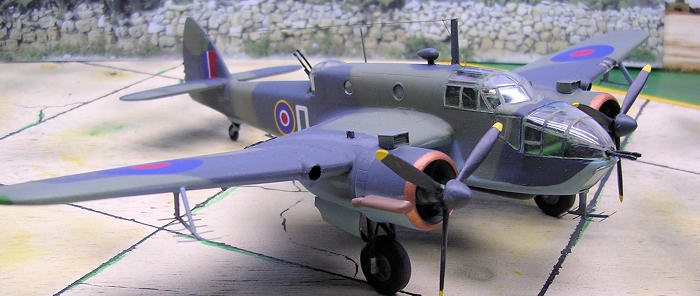
| KIT #: | ? |
| PRICE: | $ |
| DECALS: | Three options |
| REVIEWER: | Carmel J. Attard |
| NOTES: | Short run with resin and photo etch parts. |

| HISTORY |
In April 1936, the type 152 proposal was submitted to meet the Air Ministry
specification M15/35 for a torpedo bomber and Specification 24/35 for a
general reconnaissance aircraft. Design work initiated in March 1937 and the
prototype (L4441) first flew on 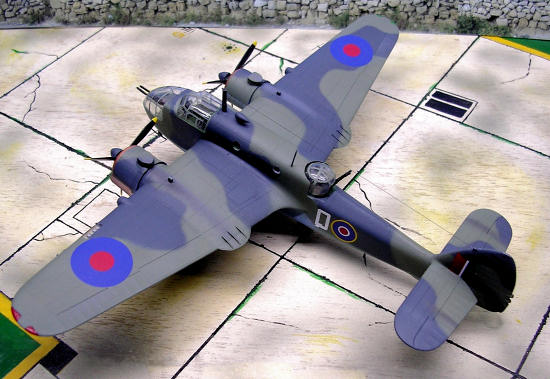 carriage
of a torpedo in a semi retracted position. This involved also a redesign to
accommodate a crew of four. This resulted into a high roofline, which became
the distinguishing feature of a new aircraft, subsequently named as the
Beaufort.
carriage
of a torpedo in a semi retracted position. This involved also a redesign to
accommodate a crew of four. This resulted into a high roofline, which became
the distinguishing feature of a new aircraft, subsequently named as the
Beaufort.
Initially there were teething troubles with the new engine that
caused delays to entry into service. At first the Beaufort was equipped with
one .303” machine gun in the port wing and two in the dorsal turret. Later a
rear-firing gun was added in an offset blister beneath the nose. Some
aircraft also carried twin guns in the nose and two others in beam position.
965 Beauforts were built by
In
November 1940 one aircraft was flown with a 1200hp Pratt and Whitney Twin
Wasp engines. Following that 415 similar powered Beaufort IIs were built for
the RAF. Some were later converted, as operational trainers, with a dorsal
turret faired over.
Beauforts in
Beauforts were diverted from areas in 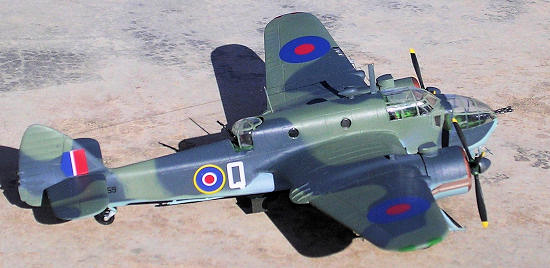 The
217 Sq arrivals in Malta was of tremendous utility as they strengthened the
depleted remains of No 39 Sq detachment and so made up for the losses both
on ground and in the air. The Order of Battle on the island on 30.6.42
included Beaufort in both 217 and 39Sq based at Luqa airfield. The local
population gained a lot of morale when the additional Beauforts alongside
other aircraft as the Beaufighters that found their base in
The
217 Sq arrivals in Malta was of tremendous utility as they strengthened the
depleted remains of No 39 Sq detachment and so made up for the losses both
on ground and in the air. The Order of Battle on the island on 30.6.42
included Beaufort in both 217 and 39Sq based at Luqa airfield. The local
population gained a lot of morale when the additional Beauforts alongside
other aircraft as the Beaufighters that found their base in
No 39 and 217 Squadrons remain known for taking part in attacks on
the Italian Fleet which put to sea to intercept two Allied convoys that had
set out from different ports in the Mediterranean aiming for the much needed
relief of the island. Beauforts were known to have attacked enemy shipping
en route as well as in harbour near Reggio Calabria and in
Like the 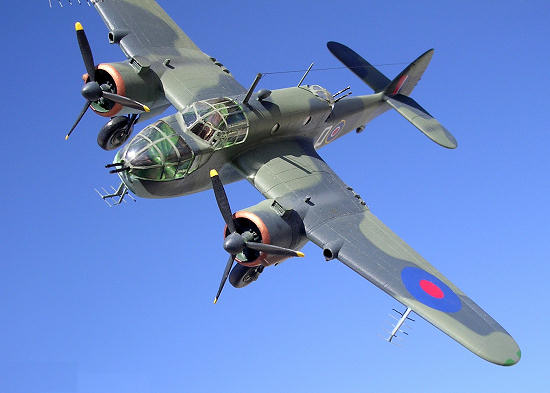 will remain a mystery and unsolved moreover since the temperate land and sea
schemes of dark sea grey and dark slate grey was highly contrasting paint
that often showed in black and white photos. This makes it difficult to
discern from tropical camouflage of stone and earth. I have seen colour
photo of Beaufort Mk1 of 217 Sq serial No L9878. ( see
will remain a mystery and unsolved moreover since the temperate land and sea
schemes of dark sea grey and dark slate grey was highly contrasting paint
that often showed in black and white photos. This makes it difficult to
discern from tropical camouflage of stone and earth. I have seen colour
photo of Beaufort Mk1 of 217 Sq serial No L9878. ( see
| THE KIT |
The Beaufort Mk 1 kit has already been issued earlier by Special
Hobby.
The kit comes in 94 medium grey plastic parts attached to five
sprues. There are also 13 clear parts on a single sprue and 28 light cream
parts encased in a sealed bag. Another sealed bag contains a single fret
with 12 parts. There are decals for three aircraft mentioned earlier and an
instruction booklet of A5 size with history; sprues and parts plan layout
and three pages of markings drawings. There is no doubt that with so many
parts the kit will build into a highly detailed model. There are sufficient
parts for either of two versions of Beaufort, Mk1a or a MkII. There is also
an extra-extended fin part in case the Australian AF version will be built
but no markings are supplied for this type. So it is assumed that in near
future there will be a kit released in this livery as well. The kit contains
highly detailed resin engines complete for either of the two types and with
individual cowlings, separate nacelle
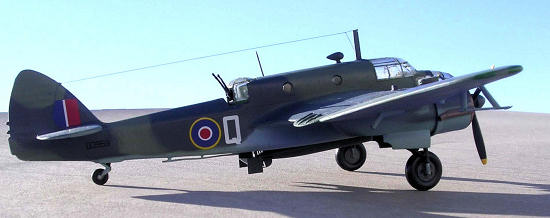 parts
and wheel well doors to go with either the
parts
and wheel well doors to go with either the
Both the Beaufort Mk1a and Mk II carry the detailed wing and nose mounted
radar array. The Mk1a has the original
| CONSTRUCTION |
The following were observations that I made during the assembly. The dorsal turret base needs to be cut from centre and have some 2mm removed from its circumference in order to fit inside the 2-part clear dome blister assembly. Also the rectangular gun access opening in the clear gun blister is best done by drilling several small holes on a premarked square followed by shaping with a rectangular smooth file. The nose perspex also needs either two or a single hole to be carefully drilled to allow guns position.
The resin engines need a central hole to be drilled to take the
propeller shaft. This is best done before the part is fitted inside the
cowling. The kit contains three types of gun blisters. These are injection
moulded and very clear and only one type is used, the rest are for possible
release in future of variations of the Beaufort. While examining photos of
the aircraft port leading edge I noticed that there were a twin light fitted
in an opening on the leading edge of the port wing. I would have expected
Special
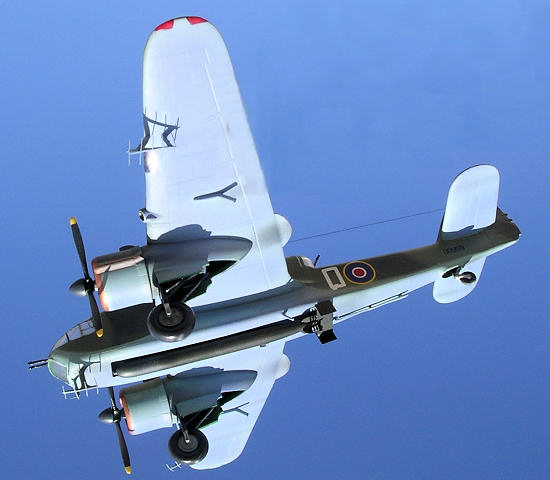 Hobby
to save me building this from scrap clear plastic as shown in photos if only
a perspex piece was provided for these lights. The operation consisted of
filing an opening on the leading edge and fit inside a solid perspex piece
which had two blind holes drilled from the inside. These two holes will
represent the twin light inside which will show up quite effectively when
polished.
Hobby
to save me building this from scrap clear plastic as shown in photos if only
a perspex piece was provided for these lights. The operation consisted of
filing an opening on the leading edge and fit inside a solid perspex piece
which had two blind holes drilled from the inside. These two holes will
represent the twin light inside which will show up quite effectively when
polished.
I also noted that when the two fuselage halves are joined together there is a tendency that the upper edge of the fuselage when put together tended to curve inwards so that the clear plastic nose piece will leave a stagger due to overlap. To correct this I inserted a 12mm x 3mm dia. sprue piece across to keep the upper nose sides to conform to cockpit width. The fuel drainpipes E10 fitted under the wing were drilled at the ends. Their position under the wing is correct but is faintly marked and should not be overlooked. Part No18 is again a surplus item for the types provided. Careful study of alternative Beaufort types brought me to the conclusion that this item is in fact a retractable antenna fitted on earlier Beauforts. This is normally fitted on the starboard side of the roof and when extended it forms a rhombus shaped antenna and is fitted in place of the bullet shaped antenna. One may draw the attention to the manufacturer that the bullet shaped antenna should have been made out of clear plastic and not solid grey component.
There are two tiny fairings to be added over the wing nacelle. These were made from rectangular 1x2x2mm plastic pieces, one on each of the nacelles. One final observation is that the inclined antenna that was fitted to the starboard side of the bomb bay (part No6) is not indicated on the instruction assembly sheet although it is shown on the box art as well as on the 4-view plans. These plans also show a round camera port fitted under the fuselage and the position has its centre 55mm from the forward edge of the bomb bay and 23 mm from the rear end of the bomb bay. The opening has a diameter of 3mmand I used Kristal Kleer to it as I did with all the fuselage portholes.
| COLORS & MARKINGS |
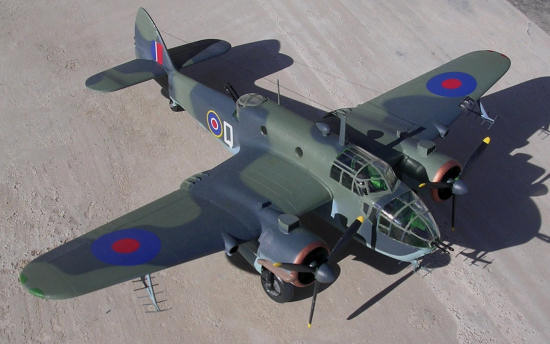 Special
Hobby tends to go by Gunze Sangyo colours reference. I have the feeling that
modellers prefer to go for a more practical reference as Humbrol
(Testors Model Master if you live in the US. Ed)
and for this benefit a quick equivalent are as follows: H8=Humbrol 11 or
silver; H12=Humbrol 33 or black; H17=Humbrol 10 or dark brown, H77= Humbrol
33 or black, H312 = Humbrol 120 or light cockpit green and H28 =Humbrol 201
or metallic black.
Special
Hobby tends to go by Gunze Sangyo colours reference. I have the feeling that
modellers prefer to go for a more practical reference as Humbrol
(Testors Model Master if you live in the US. Ed)
and for this benefit a quick equivalent are as follows: H8=Humbrol 11 or
silver; H12=Humbrol 33 or black; H17=Humbrol 10 or dark brown, H77= Humbrol
33 or black, H312 = Humbrol 120 or light cockpit green and H28 =Humbrol 201
or metallic black.
This issue came in markings of RAF Sq No22 and 217 both based at St
Eval airfield circa 1941. So once again we have a Beaufort and this time it
is released in slightly different markings for a MkII AW347, BX-S of 86 Sq
based at Kitten Airbase, Scotland circa Spring 1942; a Beaufort MkII DD896,
G of 39 Sq based at Luqa airfield, Malta during late 1942 and a Beaufort
Mk1a DD595 of 217 Sq again based at Luqa in 1942. With the exception of the
86th Sq one which has a black
underside the aircraft are in the 2 tone camouflage of dark slate grey and
extra dark sea grey upper and azure lower.
| CONCLUSIONS |
I enjoyed
building this model maybe because it has connections with the island of
Malta but I am certainly pleased with the end result and my final comment is
that the kit will be much appreciated if built by an experienced modeller.
June 2009
If you would like your product reviewed fairly and quickly, please contact me or see other details in the Note to Contributors.